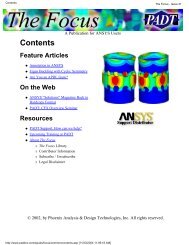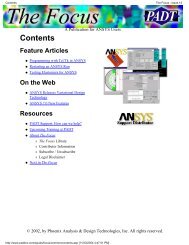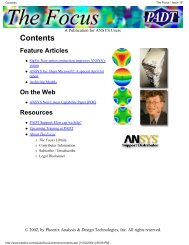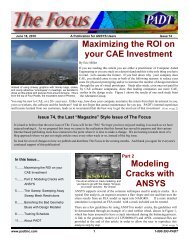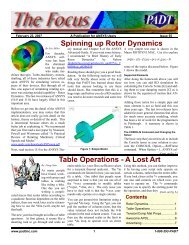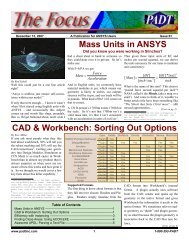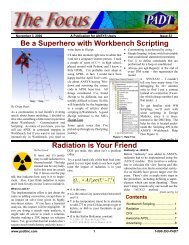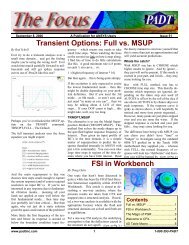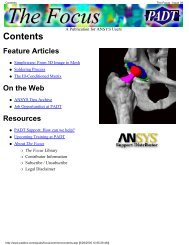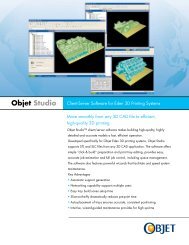Tools Every ANSYS User Should Have - PADT
Tools Every ANSYS User Should Have - PADT
Tools Every ANSYS User Should Have - PADT
You also want an ePaper? Increase the reach of your titles
YUMPU automatically turns print PDFs into web optimized ePapers that Google loves.
October 23, 2008 The Focus Issue 68<br />
October 23, 2008 A Publication for <strong>ANSYS</strong> <strong>User</strong>s Issue 68<br />
By Doug Oatis<br />
After Rod's in-depth analysis of structural<br />
shells to solid connections, I figured it was<br />
time to write about the thermal shell-solid<br />
capabilities within <strong>ANSYS</strong>. We all know<br />
that many features are omitted from the<br />
CAD model that's given to an analyst, but<br />
few are as important as a thermal barrier.<br />
This thin layer would be just about impossible<br />
to create as a solid (unless you're really<br />
good at using your CAD package), that's<br />
why <strong>ANSYS</strong> introduced SHELL131/132.<br />
It isn't everyday that you come across an<br />
extremely useful, powerful, yet simple to<br />
use element. By default, thermal shells<br />
have DOFs at the top (TTOP), bottom<br />
(TBOT), and at the internal layers<br />
(TEx) . This makes it problematic<br />
when connecting it to<br />
thermal solids, which only have<br />
a TEMP DOF. Luckily, with a<br />
simple flip of a keyoption, you<br />
can replace TTOP or TBOT with<br />
the TEMP DOF, rather than writing<br />
your own constraint<br />
equations to tie together the shells to<br />
underlying solids.<br />
So, by setting KEYOPT(6)=1 and<br />
using the ESURF command, you<br />
can do your best Bob Ross impression<br />
and paint some happy little<br />
shells wherever you want in your<br />
model! After you paint the shells<br />
on, you can then apply convection to<br />
the top (face 2). Bob's painting was<br />
creating by plotting shells with the<br />
section properties turned on<br />
(/ESHAPE,1).<br />
To properly define the<br />
SHELL131/132, you will need to<br />
By Rod Scholl<br />
Continuing from last<br />
month's article (link)<br />
we explore the various methods of attaching shell element to solid<br />
element regions. First we explored sharing nodes, especially using<br />
a "painted on region" or overlap region to transfer the moments.<br />
Table of Contents<br />
Painting “Happy” Thermal Barriers ------------------------1<br />
Shell to Solid Interfaces: Using CE’s ---------------------1<br />
Free Software <strong>Tools</strong> -------------------------------------------5<br />
New on X<strong>ANSYS</strong> ----------------------------------------------4<br />
News and Links ------------------------------------------------7<br />
Painting “Happy”<br />
Thermal Barriers<br />
use sections (rather than a real constant).<br />
This will allow you to specify multiple<br />
layers/materials, integration points, and section<br />
offset (should be SECOFFSET,BOT<br />
when using the paint option).<br />
Now you're probably wondering how to use<br />
this in Simulation. All you need is a named<br />
(Cont. on pg. 7)<br />
Shell To Solid Interfaces:<br />
Using Constraint Equations<br />
Then we looked at using contact (CONTA17x) technology. This<br />
time we will look at constraint equations.<br />
Then to complicate matters, and close out the series of articles, we<br />
will look at cases of mis-matched mesh between the solids and<br />
shell elements and compare our developed methodologies.<br />
We defined our test case previously (link), and showed a theoretical<br />
equivalent stress of 100 in the shells at the interface, and 4.00<br />
at the base of the solid.<br />
Coupled Connection<br />
It is not that uncommon to couple/constraint equation (CP, CE, or<br />
CERIG/CEINTF) the solid elements to the shells. We have to keep<br />
in mind that the equations do not update for large deflection (as<br />
they do when using the contact method with MPC<br />
(Cont. on pg. 2)<br />
www.padtinc.com 1 1-800-293-<strong>PADT</strong>
October 23, 2008 The Focus Issue 68<br />
(Shell-Solid cont...)<br />
equations, or using the MPC184 elements). Also, it is possible to<br />
unintentionally create an infinitely stiff corner, giving quite altered<br />
results. The real difficulty with this approach is apparent<br />
with the butt joint. However, let us look at the magnitude of the<br />
error, compared to the other approaches.<br />
The Overlap Joint<br />
For the overlap joint, I'm not sure why we wouldn't just share<br />
nodes with the overlapping shell elements if the mesh matches, but<br />
for argument’s sake, we show that coupled nodes at the interface<br />
(Figure 1) matches the shared nodes result (Figure 2) from the<br />
previous article (link).<br />
Figure 3: Coupled Nodes<br />
Figure 1: Coupled Nodes<br />
Figure 4: Shared Nodes<br />
Figure 2: Shared Nodes<br />
Angle Butt Joint<br />
I confess, I might just like saying "angle steel butt joint"… but I<br />
digress. Similar to the overlap joint above, the coupled result<br />
(Figure 3) matches the shared result (Figure 4) from the previous<br />
article (link).<br />
Butt Joint<br />
Note that couples (CP's) can only couple together active DOF's -<br />
and given that we need to restrain the rotational DOF's (Rotx, roty,<br />
rotz) on the shell elements, we remember that the solid elements<br />
do not have these types of DOF's active (they only have UX, UY,<br />
UZ). This is why we will use constraint equations (CE's) rather<br />
than couples to join this type of interface. These CE's will tie the<br />
different DOF's together by grabbing nodes an element length<br />
away from the shell-solid interface.<br />
To generate the CE's we have a few options.<br />
1) Use CEINTF with nodes selected from the shells<br />
2) Use CEINTF with nodes selected from the solid<br />
3) Use CERIG<br />
4) Write our own CE's<br />
Option 1), can give the CEINTF macro problems as you see in<br />
Figures 5. Using a different selection tolerance, we arrive at<br />
Figure 6 results. Here we get some odd results (Figure 7) at the<br />
interface (but by now we're used to that).<br />
Option 2) also confuses the CEINTF macro (not really intended<br />
for this sort of thing) and results in problems as seen in Figure 8<br />
(Cont. on pg. 3)<br />
www.padtinc.com 2 1-800-293-<strong>PADT</strong>
October 23, 2008 The Focus Issue 68<br />
(Shell-Solid cont...)<br />
Figure 5: CEINTF With First Tolerance<br />
Figure 8: CEINTF Generated Connections<br />
our desired interface, and came up empty handed. Best I can tell<br />
there's no way to take advantage of the CERIG generated equations<br />
for this non-standard usage.<br />
So Option 4), writing our own CE's is really our only hope for the<br />
couple/constraint equation approach for the butt joint. We have<br />
lots of choices on how to write these.<br />
Remember that we have been using contact elements, with the<br />
MPC algorithm (and small deformation) and it is equivalent to<br />
using constraint equations (note you can list the internally generated<br />
constraint equations via command CELIST,,,,INTE) as shown<br />
in Figure 9.<br />
Figure 6: CEINTF With Second Tolerance<br />
Figure 7: Odd Results from CEINTF<br />
Option 3) would employ the CERIG algorithm. This has the<br />
dramatic drawback that it adds rigidity not only in rotation, but also<br />
in UX, UY, UZ! I toyed with ways around this while still enforcing<br />
Figure 9: MPC Constraints<br />
Also we could try the CEINTF command, and get results similar to<br />
above depending on what elements we include. My first few trials<br />
didn't produce anything that looked superior to the contact generated<br />
ones, or any different from the CEINTF generated in the above<br />
cases of the lap joint and angle butt joint.<br />
So, if we are to write our own CE's, by adjusting coefficients we<br />
can pretty much distribute the load in any fashion we'd like. I<br />
suppose for this article, if we have in mind to disregard local<br />
(Cont. on pg. 4)<br />
www.padtinc.com 3 1-800-293-<strong>PADT</strong>
October 23, 2008 The Focus Issue 68<br />
(Shell-Solid cont...)<br />
results, and prioritize results at removed locations, we would attach<br />
rigidly to the closest nodes only. This numerically makes an<br />
infinitely stiff corner from the mid-side nodes inward. We will<br />
couple in UX, UY, UZ at the coincident nodes at the interface.<br />
And we'll look at three cases of tying rotation about X, by coupling<br />
Figure 10: Tying Rotations about X<br />
the side and top midside nodes' deflection with the shell node's<br />
rotation. Figure 10.<br />
Looking at the first two, CE's Option 1 and 2 (in yellow) created<br />
using the CEINTF algorithm, we can find nothing really redeeming<br />
about that approach.<br />
For the manually created set (in grey), we see that the stress in the<br />
solid at the interface is quite low - but as always we will forgo that<br />
accuracy knowing it is anti-conservative and will be handled separately<br />
in our design. We see the nice benefit of the nodal solution<br />
matching the element solution which is always nice.<br />
However, we see the accuracy at the base is still around 1% error.<br />
This isn't great, but maybe is tolerable. Add in the difficulty of<br />
loading scenarios which are not as simple as our case (rotation only<br />
about X) and I don't see any reason to write the CE's manually.<br />
There seems to be no advantage over the overlapping shell or the<br />
175's (Nodal Contact) approaches.<br />
Conclusions<br />
It probably isn't wise to take my word for it, but for all of our<br />
reference, let me distill the last three articles into some rough<br />
conclusions:<br />
Lap Joint:<br />
For lap joints, the nodal contact (CONTA175) approach is best,<br />
remembering that the solid stresses at the interface are greatly<br />
non-conservative, and must be handled differently if they drive the<br />
design.<br />
Angle Steel Butt Joint:<br />
For angle butt joints, the nodal contact (CONTA175) approach is<br />
best, remembering that the solid stresses at the interface are greatly<br />
non-conservative, and must be handled differently if they drive the<br />
design.<br />
Butt Joint:<br />
We probably can breathe a sigh of relief knowing we do not have<br />
to write our own CE's, nor is it worthwhile to bias the mesh at the<br />
joint.<br />
Also, with meshes that do not match at the interface, we should<br />
proceed with the CONTA175 approach - it is suitably accurate, and<br />
waaaaaay easier than writing our own CE's.<br />
But for matched meshes, I have to side with the overlapping shells<br />
on the top surface, rather than contact technology (CONTA175)<br />
because of the better stress results at removed locations, and higher<br />
(more accurate) stress in the solid region near the shell to solid<br />
interface (although still quite non-conservative). The nodal contact<br />
is a close runner up, and is likely sufficient for the bulk of analyses.<br />
Configuration<br />
Included<br />
Surfaces<br />
Shell Stress<br />
(Nodal)<br />
Shell Stress<br />
(Element)<br />
Base Stress<br />
(Nodal)<br />
Solid Interface<br />
Stress<br />
CE’s, Option 1 NA 162.0 244.7 3.95 10.20<br />
CE’s, Option 2 NA 350.4 350.4 2.30 34.90<br />
CE’s, Manual Top Top 99.9 99.9 3.95 3.57<br />
CE’s, Manual Side Side 99.9 99.9 3.95 2.22<br />
CE’s, Manual Both Both 99.9 99.9 3.95 2.30<br />
175’s (Nodal Contact) Top 100.0 100.0 3.95 4.01<br />
175’s (Nodal Contact) Side 100.1 100.1 3.95 2.70<br />
175’s (Nodal Contact) Top & Side 100.0 100.0 3.95 1.59<br />
177’s (Edge Contact) Top 224.7 239.0 3.95 3.82<br />
177’s (Edge Contact) Side 224.6 238.9 3.95 2.80<br />
177’s (Edge Contact) Top & Side 224.6 239.0 3.95 1.69<br />
Overlap Shells Top 99.9 99.9 4.01 9.59<br />
Overlap Shells Side 93.0 99.9 3.87 7.24<br />
Overlap Shells Top & Side 99.9 99.9 4.01 4.13<br />
Table 1: Summary of Results<br />
www.padtinc.com 4 1-800-293-<strong>PADT</strong>
October 23, 2008 The Focus Issue 68<br />
Free <strong>Tools</strong> <strong>Every</strong> Analyst <strong>Should</strong> <strong>Have</strong><br />
Compiled by Eric Miller<br />
Engineers like clever tools, and they like<br />
free stuff. So free and useful software tools<br />
are always of interest. Over the years everyone<br />
here at <strong>PADT</strong> has built up a library<br />
of free software programs that they use on a<br />
regular basis. So we thought it would be a<br />
good idea to get a list of them and share it<br />
with the user community.<br />
Some are pretty major (Python, OpenOffice)<br />
and some are small. They are all free<br />
to download and most have been around for<br />
a while and are robust and well supported<br />
by the community or author.<br />
If you have one of your favorite tools to<br />
add, e-mail us at focus@padtinc.com.<br />
We’ll publish a list of links next month.<br />
Python<br />
Scripting Language<br />
www.python.org<br />
Python is the productivity scripting language.<br />
No ifs, ands or buts about it. For<br />
those of us that are older, the object oriented<br />
nature of the language takes a little getting<br />
used to, but beyond that it is simple to learn,<br />
very concise and very powerful. It is also<br />
very widely accepted, has a huge library of<br />
pre-written routines, and has been linked to<br />
tons of tools out there. It can be run in batch<br />
or be used to make a graphical user interface.<br />
If you are automating processes for<br />
any engineering task, it would be hard to<br />
find a better tool to do it in than python.<br />
Vim:Vi Improved<br />
Text Editor<br />
www.vim.org<br />
There are two kinds of text editor users,<br />
those who fumble around with a mouse and<br />
those who use Vi. For writing code or<br />
managing input and output files nothing<br />
beats Vi for speed, once you have memorized<br />
the archaic key strokes. And Vim is<br />
the leading Vi editor for Windows. It works<br />
like Vi on *nix with some extra GUI type<br />
functions that are useful. It also has text<br />
highlighting for most scripting languages,<br />
including APDL.<br />
OpenOffice<br />
Office Software<br />
www.openoffice.org<br />
Beyond text editing, and for free, there is<br />
only OpenOffice. This incredibly powerful<br />
Office suite offers 80%-90% of what MS<br />
Office does, but is open and free. And it<br />
reads and rites MS file formats. And, if you<br />
are a Linux user, this is the best office suite<br />
for that OS. We find that it is not compatible<br />
enough with MS Office to make it our<br />
primary tool, but for the type of things that<br />
an FEA/CFD guy does, it is plenty powerful.<br />
LaTeX<br />
Batch Typesetting<br />
www.latex-project.org<br />
<strong>Have</strong> you ever wanted to be able to create<br />
professional looking documents in batch<br />
mode or with a script? LaTeX has been<br />
around a long time and is an incredibly<br />
powerful way to automate the formatting of<br />
your document in-line with the document. It<br />
actually started life as a typesetting language<br />
before WYSIWYG editors. We often<br />
use it with python or APDL to automatically<br />
create nicely formatted documents on the<br />
fly. It is also useful for formatting nasty<br />
math equations, and outputs to PDF.<br />
CutePDF Writer<br />
PDF Writer<br />
www.cutepdf.com<br />
Although Office 2007 now saves as PDF<br />
(yea!) you still often need a good PDF<br />
creator. CutePDF seems to be the the best<br />
free “print-to-pdf” tool out there. We find<br />
it works pretty well.<br />
GSView<br />
PDF Viewer<br />
www.cs.wisc.edu/~ghost/gsview<br />
Ghostscript is the opensource clone of Postscript,<br />
and GSView is a tool for looking at<br />
ghostscript and Postscript files. If you produce<br />
raw *.ps or *.gs files, you need this tool.<br />
Movietogif<br />
Animation Converter<br />
www.evanolds.com/movtogifsimple.html<br />
Ever make an AVI of an animated result and<br />
then struggle to get it into a PowerPoint or on<br />
a web site. Movie to Gif is a simple little tool<br />
that converts from MPEG or AVI into GIF.<br />
And once in GIF you can imbed in your PowerPoint<br />
or put it on a web site.<br />
Irfanview<br />
Image Viewer<br />
www.irfanview.com<br />
Simple, super fast, and compact tool for looking<br />
at images and movies. It has some simple<br />
editing tools as well. Instead of firing up a big<br />
graphics program, for windows this is the<br />
fastest way to view almost any format. Sorry<br />
NOT FREE, small fee for commercial use.<br />
ImageMagick<br />
Image Converter<br />
www.imagemagick.org<br />
Command line based tool for modifying,<br />
translating and converting images. This is<br />
“the tool” for batch conversion, cropping<br />
and filtering of images. We use it to automate<br />
the creation and editing of results<br />
plots, including stuff like cropping, adding<br />
logos and converting formats.<br />
AnyDWG<br />
Image Converter<br />
anydwg.com<br />
This is actually a suite of tools for converting<br />
to and from Autocad formats. If you<br />
don’t have a program that reads<br />
DWG/DXF, then DWG to PDF is a great<br />
way to convert to PDF. If you have a PDF<br />
of a part you want to model but need to get<br />
it into CAD, PDF to DXF will do that conversion<br />
for you. Simple but a big time saver.<br />
TheGimp<br />
Image Editor<br />
www.gimp.org<br />
OK, the name is really bad. But if you can<br />
get beyond that you will find an image<br />
editing tool that is incredibly powerful. It<br />
runs on Linux and Windows and provides<br />
all the tools that even hard-core Photoshop<br />
users like. If you need to clean up plots, add<br />
annotation or crop things a lot, this is the<br />
best free tool out there, and better than most<br />
commercial tools. This is a must have if<br />
you don’t want to pay for Photoshop or<br />
PaintShopPro.<br />
Enguage<br />
Graph Digitizer<br />
digitizer.sourceforge.net<br />
Don’t you hate it when you ask for material<br />
properties and you get a graph printed on<br />
paper? Instead of breaking out the ruler try<br />
Enguage. This simple program takes an<br />
image and automatically finds the axis and<br />
the curves. It has tools for cleaning up the<br />
image and setting stuff up if the automatic<br />
stuff doesn’t work 100%. This program has<br />
saved us dozens of hours and a lot of frustration.<br />
(Cont. on pg. 6<br />
www.padtinc.com 5 1-800-293-<strong>PADT</strong>
October 23, 2008 The Focus Issue 68<br />
(Free tools cont...)<br />
Gnuplot<br />
Graphing<br />
www.gnuplot.info<br />
Let’s be honest, most of us make graphs in<br />
<strong>ANSYS</strong> or Excel, and both programs kind<br />
of suck at making graphs. Gnuplot has been<br />
around forever and produces high quality<br />
graphs, in batch mode, in 2D and 3D with<br />
all the bells and whistles you could ask for.<br />
Using APDL, python or by creating simple<br />
input files, you can take pretty much any<br />
simulation value and make nice graphs in<br />
the background. Next time you get frustrated<br />
trying to graph something, think Gnuplot.<br />
GeoGebra<br />
Math Tool<br />
www.geogebra.org<br />
This program is amazing. If you ever find<br />
yourself doing algebra or calculus and you<br />
want to visualize your equations, GeoGebra<br />
is the right tool. Type in an equation and<br />
see it on the screen. Drag points around and<br />
watch the equations change. Very fast, very<br />
powerful. A great visualization tool.<br />
SciLab<br />
Math Tool<br />
www.scilab.org<br />
SciLab is basically an OpenSource version<br />
of MatLab. They describe it as “a scientific<br />
software package for numerical computations<br />
providing a powerful open computing<br />
environment for engineering and scientific<br />
applications” It is extremely powerful and<br />
although not 100% as powerful as MatLab,<br />
it is pretty dang close and for most analysts<br />
probably close enough. There are other<br />
similar tools (Octave being one) but this<br />
seems to be the dominant one. Also, it has<br />
a Simulink system simulator similar to<br />
LabVIEW.<br />
TightVNC<br />
Remote Desktop<br />
www.tightvnc.com<br />
Be honest, all of us are always logging on to<br />
our machines at work from home or while<br />
on vacation. Windows remote desktop is<br />
OK but it logs you off the remote machine.<br />
VNC lets you share your desktop and often<br />
works faster, and it works with Linux. It<br />
can also handle slow connections better<br />
(you can reduce color and such). There are<br />
many flavors, but we have found TightVNC<br />
to be reliable and compact.<br />
Putty<br />
SSH Tool<br />
www.putty.org<br />
Another silly name. These OpenSource<br />
Linux guys! If you work on a bunch of<br />
machines and want to manage SSH connections<br />
to them, Putty is the way to go. It is<br />
also a good way to add SSH to a Windows<br />
box. If you don’t know what SSH is, you<br />
probably don’t need Putty.<br />
cygwin<br />
Linux Emulator<br />
www.cygwin.com<br />
You either love cygwin or you hate it. We<br />
love it. Cygwin is a Linux and X-Windows<br />
environment that runs on windows. If you<br />
have a windows desktop and you use remote<br />
Linux or Unix machines, cygwin is<br />
the free way to connect to them and view<br />
graphics. Also, if you are a big Linux/Unix<br />
fan and can’t function outside of that environment,<br />
but you are forced to have a windows<br />
box, you can have your cake and eat<br />
it too with cygwin. This is a must have for<br />
those with Linux compute servers.<br />
CP16<br />
Calculator<br />
www.hpcalc.org/hp48/pc/emulators<br />
Long for reverse polish notation? This web<br />
site has a whole slew of HP calculator<br />
emulators. The CP16 seems to be the best<br />
of the lot.<br />
Dropbox<br />
File Sharing<br />
www.getdropbox.com<br />
This is a program and a web service that<br />
some of us have found very useful and a big<br />
time saver. You load the software on all of<br />
your computers, and it syncs the files in a<br />
specified “dropbox” folder on all the machines.<br />
You can also access the files<br />
through a web interface. It is limited to 2GB<br />
but is a great way to keep a set of important<br />
files available across home, work, laptop<br />
and while you are on the road.<br />
FileZilla<br />
FTP Utility<br />
filezilla-project.org<br />
For whatever reason, FTP isn’t as simple as<br />
it used to be. FileZilla takes the difficult out<br />
of it and allows you to avoid trying to use<br />
your browser to get at files. Many of us<br />
have been using it for some time and a lot of<br />
our file transfer problems have gone away.<br />
7-Zip<br />
File Compression<br />
www.7-zip.org<br />
WinZip has almost become synonymous<br />
with file zipping. And Windows now supports<br />
ZIP files. But WinZip is not free (didn’t<br />
know that? Thief!) and every once in a while<br />
we would run across an archive format that<br />
we couldn’t read. 7-Zip, silly name again,<br />
reads almost everything (#7z, ZIP, GZIP,<br />
BZIP2, TAR, RAR, CAB, ISO, ARJ, LZH,<br />
CHM, MSI, WIM, Z, CPIO, RPM, DEB and<br />
NSIS) and writes to 7z, ZIP, GZIP and TAR.<br />
It is fast and works really well in windows<br />
under the right mouse click.<br />
New on X<strong>ANSYS</strong><br />
The elves who keep X<strong>ANSYS</strong> up and<br />
running have been very busy (so they<br />
can finish in time for us to rent them<br />
out to Santa) making some long needed<br />
changes to the site.<br />
The most important is that X<strong>ANSYS</strong><br />
now runs as both an e-mail list<br />
(mailman listserver) and as a modern<br />
Web based forum. Experienced and<br />
seasoned users who prefer to interact<br />
through the more stable and robust e-<br />
mail method can continue to do so.<br />
Young and impatient adrenaline junkies<br />
can use the forum. An added bonus<br />
is that the forum also serves as the<br />
archive so searching is better than ever.<br />
Sometimes you can have your cake and<br />
eat it too.<br />
www.xansys.org/forum<br />
Secondly, we’ve added a blog. Nothing<br />
too fancy and so far not a lot of<br />
posts to it. But still, a place for key<br />
people on X<strong>ANSYS</strong> to express more of<br />
an opinion than what is considered polite<br />
within the list (and now forum).<br />
xansys.blogspot.com<br />
www.padtinc.com 6 1-800-293-<strong>PADT</strong>
October 23, 2008 The Focus Issue 68<br />
(Thermal Boundary, cont...)<br />
selection (made of faces) and a command snippet. Here's a very basic one:<br />
/prep7<br />
max_type=elmiqr(0,14)<br />
shell_type=max_type+1<br />
max_secn=sectinqr(0,14)<br />
shell_secn=max_secn+1<br />
max_mat=mpinqr(0,,14)<br />
shell_mat=max_mat+1<br />
!Define scalar for shell type definition<br />
!Define scalar for shell section definition<br />
!Define scalar for shell material definition<br />
et,shell_type,132<br />
keyopt,shell_type,6,1<br />
mp,kxx,shell_type,5<br />
sect,shell_secn,shell<br />
secdata,.125,1<br />
secoffset,BOT<br />
seccontrol<br />
!Define SHELL132 (midside nodes)<br />
!Turn on paint option<br />
!Define material properties and section controls<br />
cmsel,s,face !Replace with your named selection<br />
type,shell_type<br />
mat,shell_mat<br />
secn,shell_secn<br />
esurf<br />
!Paint Happy Surfaces!!!<br />
allsel,all<br />
/solu<br />
So next time you need to do a thermal analysis that includes a thermal barrier/coating, look to SHELL131/132 for a very simple solution.<br />
Also remember to build your model in the spirit of Bob Ross, "We don't make mistakes, we just have happy accidents." Sorry, that's<br />
just my way of saying “happy debugging.”<br />
Confused again by Doug’s pop culture references? Don’t know who Bob Ross is? He was a painter who had a TV show on US Public Television that showed people<br />
how to paint. He was almost creepily calm and soft spoken and was fascinating to watch because he could create a complete forest of “happy trees” in a few minutes.<br />
Many of the “middle aged” generation would watch Bob early on Saturday mornings before cartoons came on. <br />
News - Links - Info<br />
· The SWAU Report is now Snippets! <strong>PADT</strong> is broadening<br />
the scope of our other <strong>ANSYS</strong> related publication<br />
with a new name and more news and<br />
opinion: <br />
· Engineering Simulation Energy Conference, Houston,<br />
Texas, November 11-12, 2008. <strong>PADT</strong> will be<br />
there <br />
· Info on the <strong>ANSYS</strong> <strong>User</strong> conference and what a<br />
success it was can be found here: <br />
· <strong>PADT</strong>’s 2009 Training Schedule is out. It includes<br />
some new classes and the schedule for the first half<br />
of 2009. <br />
· We recently stumbled across a new on-line resource<br />
called FEAdomain.com. It’s a forum, it’s a<br />
resource site, job listings, etc... It’s a lot of stuff. It<br />
even has expensive advertising. Unlike a lot of such<br />
sites, it has some good <strong>ANSYS</strong> related information.<br />
Looking at the forum, it is still small but someone is<br />
adding a lot of content. Worth checking out. <br />
<strong>PADT</strong>’s Training Schedule<br />
Month Start End # Title Location<br />
Oct '08 10/27 10/27 411 WB Simulation Electromagnetics Tempe, AZ<br />
10/28 10/28 206 WB Rigid & Flexible Dynamics Tempe, AZ<br />
Nov '08 11/5 11/7 101 Introduction to <strong>ANSYS</strong>, Part I Tempe, AZ<br />
11/10 11/10 702 WB DesignXplorer Tempe, AZ<br />
11/12 11/13 301 Heat Transfer Tempe, AZ<br />
11/17 11/18 102 Introduction to <strong>ANSYS</strong>, Part II Tempe, AZ<br />
11/19 11/20 204 Advanced Contact and Fasteners Tempe, AZ<br />
11/24 11/25 604 Introduction to CFX Tempe, AZ<br />
Dec '08 12/1 12/2 104 WB Simulation – Intro Tempe, AZ<br />
12/8 12/9 302 WB Simulation Heat Transfer Tempe, AZ<br />
12/10 12/11 207 WB Simulation – Struct. Nonlin. Tempe, AZ<br />
12/15 12/16 801 <strong>ANSYS</strong> Customization with APDL Tempe, AZ<br />
Jan '09 1/9 1/9 605 CFX for the Non-CFD Specialist Tempe, AZ<br />
1/12 1/14 101 Introduction to <strong>ANSYS</strong>, Part I Tempe, AZ<br />
1/15 1/16 100 Engineering with FEA Tempe, AZ<br />
1/22 1/23 651 CFX Combustion and Radiation Tempe, AZ<br />
1/26 1/27 104 WB Simulation – Intro Albq, NM<br />
1/28 1/29 207 WB Simulation – Struct. Nonlin. Albq, NM<br />
1/30 1/30 107 WB DesignModeler Tempe, AZ<br />
Feb 09 2/2 2/3 301 Heat Transfer Tempe, AZ<br />
2/4 2/5 801 <strong>ANSYS</strong> Customization with APDL Tempe, AZ<br />
2/6 2/6 411 WB Simulation Electromagnetics Tempe, AZ<br />
2/9 2/10 205 WB Simulation Dynamics Tempe, AZ<br />
2/12 2/13 652 CFX Multiphase Flows Tempe, AZ<br />
2/20 2/20 206 WB Rigid & Flexible Dynamics Tempe, AZ<br />
2/23 2/24 202 Advanced Struct. Nonlinearities Tempe, AZ<br />
Mar 09 3/2 3/3 104 WB Simulation – Intro Tempe, AZ<br />
3/4 3/5 207 WB Simulation – Struct. Nonlin Tempe, AZ<br />
3/6 3/6 107 WB DesignModeler Tempe, AZ<br />
The Focus is a periodic publication of Phoenix Analysis & Design Technologies (<strong>PADT</strong>). Its goal is to educate and entertain the worldwide AN-<br />
SYS user community. More information on this publication can be found at: http://www.padtinc.com/epubs/focus/about<br />
www.padtinc.com 7 1-800-293-<strong>PADT</strong>
October 23, 2008 The Focus Issue 68<br />
<strong>ANSYS</strong> + Mathcad<br />
<strong>PADT</strong> is Taking the Lead<br />
• Mathcad Sales and Support to<br />
<strong>ANSYS</strong> users<br />
• Development of Opensource<br />
interface tools<br />
• Training and educational materials<br />
• Stay tuned to “The Focus” to learn<br />
more<br />
www.xansys.org<br />
F o r o v e r a d e c a d e A N S Y S u s e r s a r o u n d t h e<br />
w o r l d h a v e b e e n g a t h e r i n g o n t h e X A N S Y S<br />
m a i l i n g l i s t t o s h a r e t h e i r k n o w l e d g e ,<br />
e x p e r i e n c e a n d h u m o r . J o i n t h e c o n v e r s a t i o n<br />
w i t h 3 , 5 0 0 + p r a c t i t i o n e r s o n t h e l a r g e s t<br />
i n d e p e n d e n t A N S Y S c o m m u n i t y o n t h e w e b .<br />
www.padtinc.com 8 1-800-293-<strong>PADT</strong>



